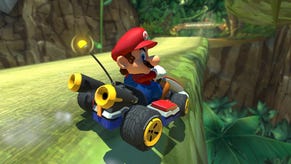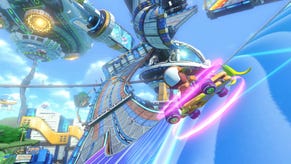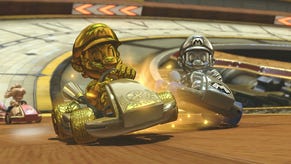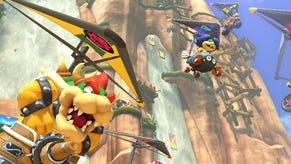Mario Kart 8 review: another solid reason to invest in Wii U
Mario Kart 8 presents a strong case for investing in Wii U. Dave Cook puts pedal to floor and accelerates into a world of joyous racing banter to bring you his final impressions.
Mario Kart 8 is more than Wii U’s visual benchmark; it's further proof that Nintendo’s focus on control and fun comes from a good place. Once you hit the tarmac and let rip with those drifts and jumps, you’ll be thankful that it didn’t try to reinvent the wheel.
During last year's Super Mario 3D World impressions I argued that Nintendo's mastery of the 3D platforming format had turned the genre into a one-horse race. Whenever the Japanese giant releases a new entry to the series, it's essentially competing with itself.
The same is true of Mario Kart, a franchise that has remained consistent at the core since 1992, yet bolstered with new tricks and features to keep it fresh over the years.
Mario Kart 8 is the culmination of that effort, a slick, enjoyable and thoroughly pleasant experience that favours old school simplicity over bogged-down mechanics and needless padding. It's perhaps the best reason to buy a Wii U today.
You'll have no trouble picking up your GamePad and getting stuck right into races thanks to the familiar control scheme, and while that may sound a tad uninspired on Nintendo's part, the carrying-over of Mario Kart 7's drift and boost mechanic is actually a smart move on Nintendo's part. The game's beauty shines through thanks to some superbly-designed courses that force players to think strategically about when to engage a drift turn to earn boost, and picking the right time to unleash it for a burst of speed.
When you're hammering along more intricate tracks like Bowser's Castle or Shy Guy Falls, simply sticking to the racing line isn't enough. You need to learn the shortcuts, figure out how to combo your drifts and boosts to maintain top speed and make smart use of your power-ups. So while Nintendo appears to have turned out another Mario Kart game with the same old control method as before, the similarities are only skin-deep.
The courses themselves have been lovingly created and look superb on Nintendo's hardware with a clean art style reminiscent of a Pixar movie. It's the most visually impressive first-party game on Wii U, and it wouldn't look out of place on PS4 or Xbox One either. It's no inFamous: Second Son or Battlefield 4 of course, but it shows that the company can achieve graphical excellence on its home format when the shoe fits.
"A game rammed full of polygons, high-quality textures and graphical trickery amounts to very little unless it handles effectively. The company has its control method honed to a point that this racer feels wonderful in your hands."
You'll feel it as you scream around the damp, coastal roads of Dolphin Shoals at 60 frames per second. As you ascend the rocky path hanging high above the bay's sparkling waters, you'll be greeted by shimmering lens flare and the sun's glare reflecting in puddles that splash loudly under your kart's wheels as you pass.
Flair aside, it's hard to dismiss the joy felt as you hammer around corners in the music-themed Electrodome, flanked by crowds of Koopa Troopers and Piranha Plants dancing to the beat, or watching gingerbread Toads bound about in joy in the grandstands of Sweet Sweet Canyon.
While the tracks have started to deviate away from levels in Mario games a little, they benefit from the same rhythmic ethos applied to jump-placement in Nintendo's platform games. Each slippery turn and jump feels deliberately placed to hold your focus until the final lap ends, and this magnetic appeal is bolstered further with the inclusion of anti-gravity sections. While these stretches of road play out the same as those found on terra firma, they make for a positively disorientating experience.
You can engage anti-gravity sections by driving over blue strips on the road, and while they can help you bypass obstacles or gain a speed boost, Nintendo has balanced them by adding additional risks such as sheer drops and other hazards. They'll see you driving horizontally along the side of store fronts in Toad Harbour, along the wobbling walls of Twisted Mansion and corkscrewing around Rainbow Road's interstellar highway. These moments make for some of the most visually-arresting tracks in Mario Kart history.
My favourite course is Mount Wario, which starts on a grid inside a high-flying plane. Once the race starts, the cargo hatch opens and everyone drops out onto the snowy piste below, thundering through frozen caves, around evergreen trees and through slalom gates to be greeted by a cheering crowd of Toads at the bottom. It's a superbly-designed sprint that rolls all of the Mario kart franchise's tricks - from hang-gliding and drifting, to boosting off the peak of jumps and anti-grav - to make something that feels fresh and most importantly of all, fun.
”Given how nice Mario Kart 8 looks in motion, the inclusion of video tools marks another smart decision on Nintendo’s part. On top of this there’s local play for up to four people, online play for up to two racers and a fresh take on the SNES racer’s classic battle mode.”
There are 16 tracks in total spread across four cups, as well as another 16 classic tracks that have been revamped to include anti-gravity and other new tricks, so they're not just simple re-treads by any measure. There's also plenty of kart customisation options from the start along with unlockable chassis, wheels and gliders that care earned after hitting certain coin tallies. The inclusion of bikes adds another layer of stategic play into the mix.
While two-wheeled vehicles are faster than karts, they over steer around drifts, making them more unwieldy during high speed 150cc events. The fact that bikes suffer in the handling department is further evidence that producer and director team Hideki Konno and Kosuke Yabuki have strived to keep gameplay on an even keel. The same cannot be said for the accursed blue shell, which still continues to infuriate, except in my experience it has become a genuine problem that needs addressed.
For those unfamiliar with the blue shell weapon, it's a projectile that seeks out the race leader and slams into them, bringing their kart to a stop for a moment. It's long been viewed as a heavy-handed form of rubber-banding that punishes players for getting too far ahead of the pack, but during my time with Mario Kart 8 at home I found myself struck by it, only to be over-taken by the racer in second and even third place almost instantly. That's simply not fair. It should only be used when the gap is significant, not while I have other racers nipping at my heels.
Perhaps these occurrences were mere anomalies but I've dropped several places and only barely clawed it back because of the blue shell. It might get patched by Nintendo post-launch, but right now I think it needs a deal of tweaking. Mario kart 8's new horn weapon can be used to blow the shell away if you're lucky enough to have one, but you need to get the timing right or it'll fail. I like the inclusion of this new counter-defence item, and it fits snugly alongside all of boomerang plant, red shell and other returning power-ups.
Another new addition is Mario Kart TV - or MKTV for short - a replay feature that condenses all of your best moments in a race into a quick highlight reel at the end of each event. It's also possible to publish footage of entire races on YouTube and MiiVerse complete with slow-mo effects for all to see. The highlight tool does a good job of framing up your best weapon strikes or overtakes to make them look cinematic, but it can also be tweaked with filters to focus on a particular driver or type of event, such as high impact collisions.
Given how nice Mario Kart 8 looks in motion, the inclusion of video tools marks another smart decision on Nintendo's part. On top of this there's local play for up to four people, online play for up to two racers and a fresh take on the SNES racer's classic battle mode, in which players attempt to pop each of the three balloons tethered to their opponent's kart.
Mario Kart 8 is more than Wii U's visual benchmark; it is further proof that Nintendo's focus on control and fun comes from a good place. I'm a firm believer that a game rammed full of polygons, high-quality textures and graphical trickery amounts to very little unless it handles effectively. The company has its control method honed to a point that this racer feels wonderful in your hands.
That's hard to convey through words or imagery, but once you hit the tarmac and let rip with those drifts and jumps, you'll be thankful that Nintendo didn't try to reinvent the wheel with this one. What this stability has done however, is allow the studio space to show that it can produce visually-arresting titles that sit comfortably among the new-gen pack. In these regards, Mario Kart 8 is up there with the rest of the new-gen pack.
Disclosure: to assist in writing this piece, Nintendo sent Dave a Mario Kart 8 download code on Wii U.
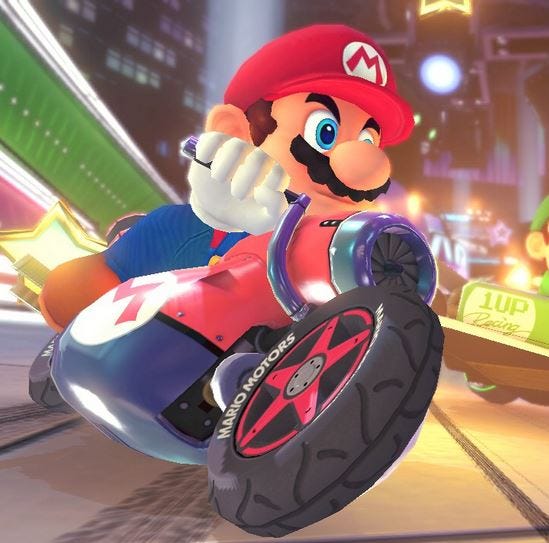






.png?width=291&height=164&fit=crop&quality=80&format=jpg&auto=webp)
.png?width=291&height=164&fit=crop&quality=80&format=jpg&auto=webp)
